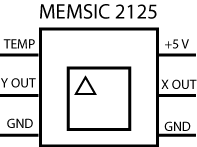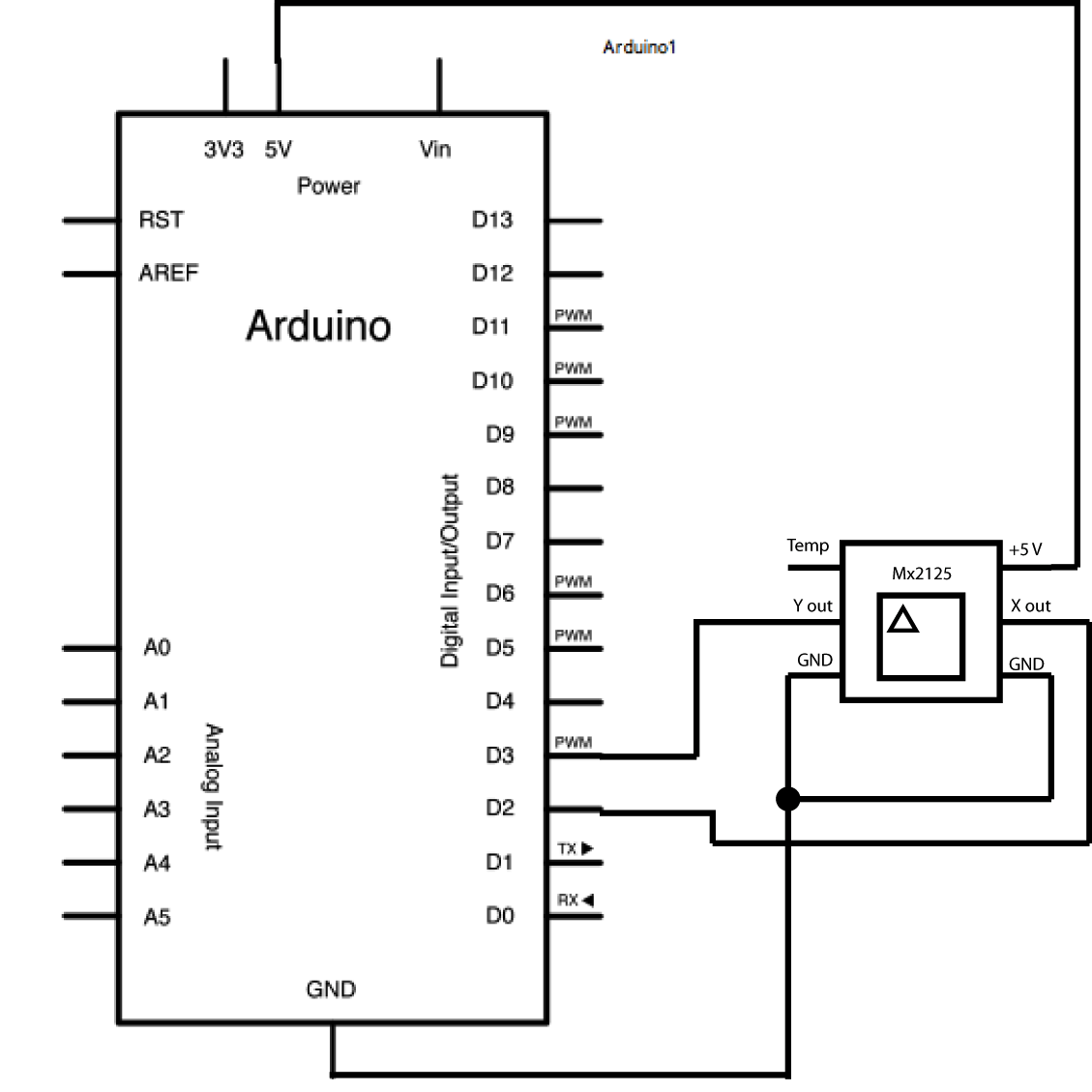Learning Examples | Foundations | Hacking | Links
Examples > Sensors
Memsic 2125 Accelerometer
The Memsic 2125 (datasheet) is a two-axis accelerometer capable of measuring acceleration up to plus or minus 2g. It has a simple digital interface: two pins (one for each axis) emit pulses whose duration corresponds to the acceleration of that axis. By measuring the length of that pulse, in microseconds, using the Arduino's pulseIn() function, it is possible to determine the rate of acceleration and to use that data for your purposes.
Hardware Required
- Arduino Board
- (1) Memsic 2125 Accelerometer
- bread board
- hook-up wire
Circuit
Use the small triangle on the Memsic to properly orient the sensor on your breadboard. Connect the 5V and GND pins of the Memsic 2125 to the power and ground ports on the Arduino. Connect digital pin 2 of the Arduino to the X out pin of the accelerometer, and digital pin 3 to the Y out pin.
Your Arduino must be connected to your computer in order for it to transmit serial data.
click the image to enlarge
image developed using Fritzing. For more circuit examples, see the Fritzing project page
Schematic:
click the image to enlarge
Code
Memsic2125
Read the Memsic 2125 two-axis accelerometer. Converts the
pulses output by the 2125 into milli-g's (1/1000 of earth's
gravity) and prints them over the serial connection to the
computer.
The circuit:
* X output of accelerometer to digital pin 2
* Y output of accelerometer to digital pin 3
* +V of accelerometer to +5V
* GND of accelerometer to ground
http://arduino.cc/en/Tutorial/Memsic2125
created 6 Nov 2008
by David A. Mellis
modified 30 Aug 2011
by Tom Igoe
This example code is in the public domain.
*/
// these constants won't change:
const int xPin = 2; // X output of the accelerometer
const int yPin = 3; // Y output of the accelerometer
void setup() {
// initialize serial communications:
Serial.begin(9600);
// initialize the pins connected to the accelerometer
// as inputs:
pinMode(xPin, INPUT);
pinMode(yPin, INPUT);
}
void loop() {
// variables to read the pulse widths:
int pulseX, pulseY;
// variables to contain the resulting accelerations
int accelerationX, accelerationY;
// read pulse from x- and y-axes:
pulseX = pulseIn(xPin,HIGH);
pulseY = pulseIn(yPin,HIGH);
// convert the pulse width into acceleration
// accelerationX and accelerationY are in milli-g's:
// earth's gravity is 1000 milli-g's, or 1g.
accelerationX = ((pulseX / 10) - 500) * 8;
accelerationY = ((pulseY / 10) - 500) * 8;
// print the acceleration
Serial.print(accelerationX);
// print a tab character:
Serial.print("\t");
Serial.print(accelerationY);
Serial.println();
delay(100);
}
See Also:
pinMode()pulseIn()serial.begin()serial.print()- ADXL3xx - read a ADXL3xx accelerometer.
- Ping - detect objects with an ultrasonic range finder.
- Knock - detect knocks/impacts with a piezo element


